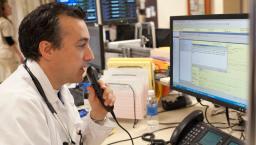Where healthcare CIOs are allocating their IT spend now

Photo: Hero Images
As new and emerging technologies show promise in helping hospitals and health systems manage challenges related to rising costs and shrinking labor shortages, chief information officers and other IT leaders are upping their investment. Almost 80% of respondents to a new Bain & Company survey said they've increased spending in the past year – and 75% saying they expect to spend even more in the year ahead.
WHY IT MATTERS
For their paper, 2023 Healthcare Provider IT Report: Doubling Down on Innovation, Bain & Company and KLAS Research polled more than 200 health IT execs earlier this summer.
The poll found that academic medical centers and large health systems are most likely to be spending more, compared with smaller hospitals, as they devote resources to innovation projects.
But across the board investments are on the rise, with more than half of respondents (56%) saying new software is one of their top three strategic priorities – compared to just one in three in 2022.
Bain and KLAS show that revenue cycle management and clinical workflow optimization are top areas of investment – and their research also shows patient engagement and cybersecurity inching up their list of priorities.
At the same time, the IT leaders who took the survey say they're looking to streamline their budgets with fewer vendor suppliers, "with nearly two-thirds of respondents saying they look first to existing vendors, especially electronic health record providers, for new functionality before evaluating new vendors and offerings."
As for the elephant in the room?
Artificial intelligence is looming large in these leaders' strategic planning, but many IT execs are still deciding just how they want to approach it. Just 6% of respondents said they have a generative AI strategy in place right now – but 50% are "actively developing one or are planning to in the near future," researchers say.
THE LARGER TREND
That AI finding jibes with another recent survey from Bain that showed IT decision-makers excited about AI and automation's potential to help them boost their financial and operational processes and ease clinician burnout. But despite their view that AI has "reached a turning point in its ability to reshape the industry," the percentage who had an organizational strategic plan for AI deployment was in the single digits.
And as for cybersecurity spending – the value of which is impossible to argue against at this point – another recent poll of a specific subset of IT leaders found many of them frustrated with the money that's been allocated to them. "The global recession is applying pressure to security budgets and how CISOs must remain steadfast in pressing the C-suite for critical controls to protect their organizations," according to a Proofpoint survey.
ON THE RECORD
"While there are many moving pieces and competing trends in the market today, providers in our survey made it clear that they will continue to accelerate their investments in IT and tech solutions, including AI," said Bain & Company and KLAS researchers in the report.
"As providers continue to face an array of structural challenges – including secular provider shortages, an aging population, and financial pressures – they will increasingly prioritize IT solutions that produce a tangible ROI and will more frequently look to simplify their tech stacks. Vendors will need to offer best-of-breed solutions or compelling suites in order to differentiate themselves."
Mike Miliard is executive editor of Healthcare IT News
Email the writer: mike.miliard@himssmedia.com
Healthcare IT News is a HIMSS publication.
























